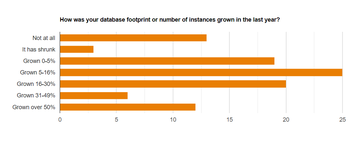In the past year, we have all seen a global surge in online activity. Data centers, co-location and cloud services have kept companies around the world going. All those new digital services have created lots of data, stretching the underlying infrastructure. Our last Open Source Data Management Software Survey indicated that companies’ database footprints grew overall, as many people faced a new work culture focused on remote working, and life in general required the use of more online services.
The 2020 survey of the open source database community saw 62 percent of respondents report that their data had grown. Of those, 12 percent said their data had grown over 50 percent. Where there is growth, there are upgrades or migration projects. 21 percent of survey respondents made ten changes or more to their cloud instances last year, revealing that many businesses potentially spent vast amounts on maintaining their cloud environments. With 2021 shaping up to be a year of consolidation and budget sensitivity, database optimization is likely to be an agenda item for many companies.
The surge in DBaaS
In particular, the Database as a Service (DBaaS) option is gaining in popularity. Use of DBaaS increased from 40 percent in 2019 to 45 percent in 2020. The reason is simple. DBaaS delivers a level of convenience that IT teams are looking for when setting up, deploying and maintaining databases, especially companies without skilled and dedicated DBAs. DBaaS helps companies manage many difficult and time-intensive database tasks, such as high availability, database patching, backups and specific security issues.
However, DBaaS is not perfect. For some users - 22 percent of survey respondents - the cost of these services can be more expensive than expected. When asked ‘what keeps you up at night?,’ survey respondents flagged downtime and performance as their biggest concerns. Performance issues were the most significant issue that companies actually experienced, impacting 74 percent of respondents.
Cost was another massive concern for companies - 81 percent of respondents said cost was a reason for them to implement more open source. However, 15 percent also flagged up costs as a potential concern around open source databases too. This is not due to the database itself, but the cost to host and run these instances.
Picking the wrong approach to implementing can lead to extra expense. This can end up costing thousands of dollars every year for an instance of a decent size. For example, an m5.xlarge instance is $0.192 an hour on EC2 whereas RDS is $0.342, which is a 78 percent premium.
You might be happy to pay this premium for the convenience it provides. It is still important to understand that the service is not necessarily fully managed, even if the marketing implies it is. In the same way that the super-deluxe burger pictured on the fast-food menu never quite reflects the meal you are served, a fully managed database is usually not as fully managed as you might expect. While you may want to hand over the day-to-day management to your provider, you will still have to decide on schema, work out how to get the most out of query design, and ensure that your security is up to scratch.
Running DBaaS can also increase the number of incidents you encounter, such as security issues, downtime, or excessive costs. You might be affected by downtime, which leads to problems in your application. To resolve this you may need to consider bringing in external expertise. The reality is that when developers choose to use DBaaS without first working with database professionals, the decision tends to come with consequences down the line. Most cloud services today are extremely reliable, but unforeseen downtime can still occur. AWS, Microsoft and Google all suffered service downtime in 2020.
Know what you are getting
It’s also important to look at DBaaS as an exchange. In return for the ease of use that you get with a cloud service, you trade being tied to that specific platform. This element of lock-in is something that all developers should be aware of before making any commitment to a service, while enterprise architects should provide guidance to their teams around this subject too.
Looking ahead in 2021, we don’t expect any companies to say that they want to use less data! Instead, we expect companies will expand their data use leading to more demand for services from the data center industry. However, the need to control costs will also be increasing. Following specialist advice will make it easier for everyone to make the most of their data, whether it is held in a data center, run as part of a managed service, or on a DBaaS platform. As more companies plan their move to DBaaS, understanding the positive and negative aspects of the service will be crucial for business success.





